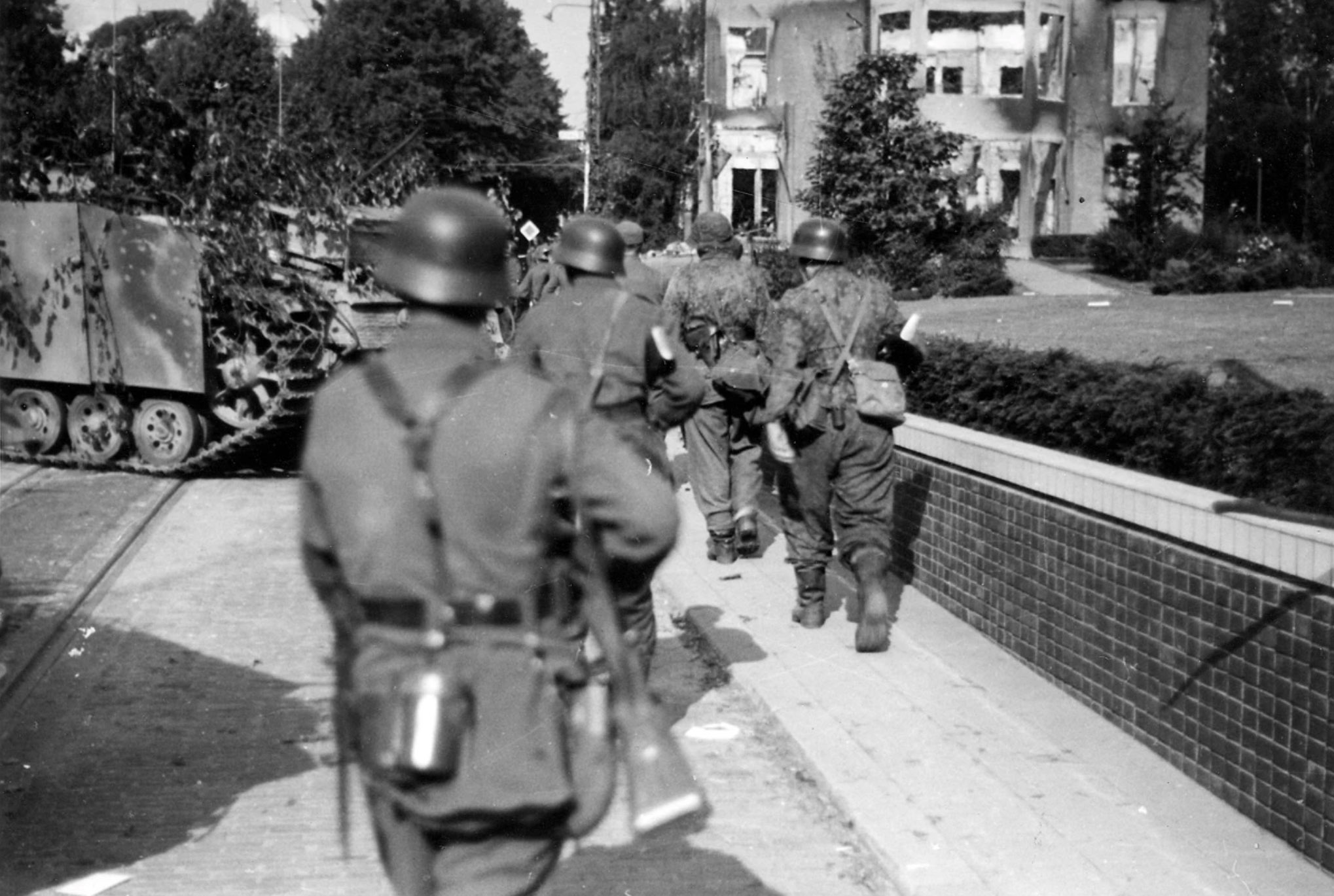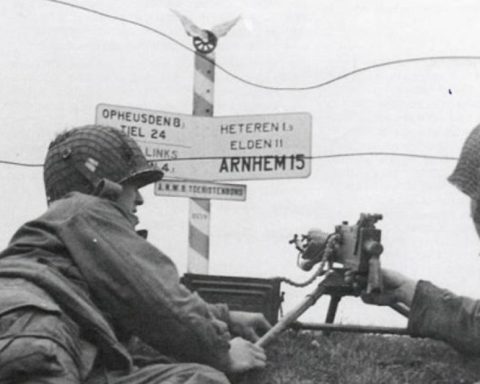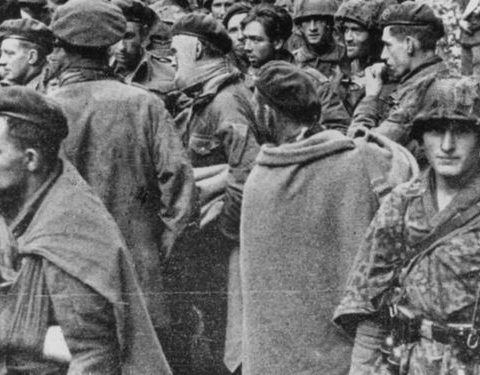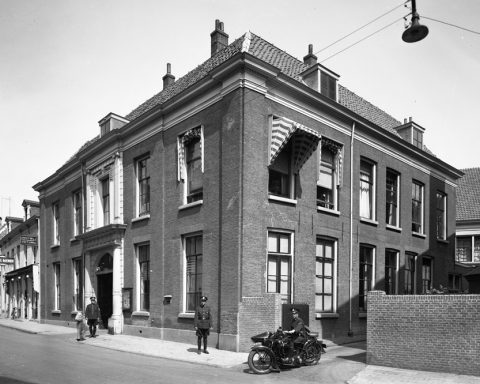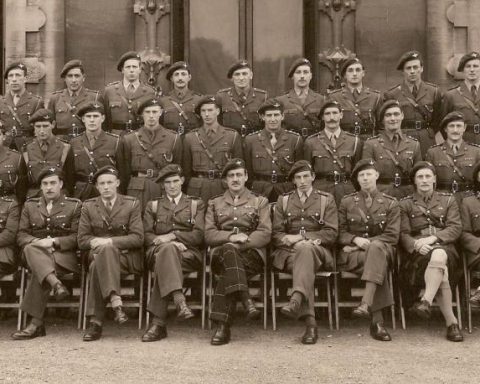Many personal accounts have been written from the English side in which soldiers describe their experiences during the Battle of Arnhem. Much less attention is paid to the Battle of Arnhem through German eyes.
Below is the story of the German Colonel Walter Harzer. Harzer was commander of the 9th SS Division Hohenstaufen and played an important role in defeating the British at Arnhem.
Harzer was one of the first protagonists to put his experiences in Arnhem on paper. At the request of the American army, Walter Harzer wrote an extensive report in 1956 describing the Battle of Arnhem through German eyes. It is a pure and objective representation of the facts.
In addition, Harzer corresponded extensively with the Dutch (amateur) historian Theodoor Boeree. Immediately after the war, Boeree started meticulous reporting of the events in Arnhem. The story below is a summary of these two sources.
The story of Water Harzer begins with a sentence that is also used in many British reports when talking about Sunday, September 17, 1944, the day of the airborne landings:
“It was a glorious day.”
While an armada of British planes is on its way to Arnhem, Harzer is in Hoenderloo. There he presents an award to the German major Viktor Graebner.
“We were on our way to the officers’ mess for lunch when we saw paratroopers in the distance. At first we thought this was about the crews of bombers that had been shot down. That was a common sight at that time.”
Harzer soon receives the message that there is more going on.
“An alarm was received that large numbers of enemy paratroopers had landed west of Oosterbeek.”
All German units of the 9th and 10th SS armored divisions stationed around Arnhem come into action. Viktor Graebner’s unit, with about 30 armored cars, is sent to Nijmegen.
“We had heard from the German army leadership that large numbers of enemy paratroopers had landed not only west of Arnhem, but also near Nijmegen. Graebner’s unit was ordered to occupy the Waal Bridge near Nijmegen and to prevent the gathering of enemy soldiers who had landed near Arnhem and Nijmegen.”
Graebner’s column of armored cars drives across the Rhine Bridge to Nijmegen around 6 p.m. Here Walter Harzer’s story deviates from official (British) historiography. John Frost’s battalion reached the Rhine bridge around 8 p.m. that evening, but according to Harzer, groups of British soldiers were already present at the bridge around 6 p.m.
“Shooting from all holes, Graebner drove over the bridge. The northern approach to the bridge was already occupied by a small number of British soldiers at that time. They lived in houses on either side of the driveway. There were no losses because the British only had light infantry weapons.”
According to Harzer, the city center of Arnhem is crawling with British soldiers around 6 p.m. These are small, isolated groups. This anecdote from Harzer is characteristic:
“When the British paratroopers arrived in Arnhem, the situation was very chaotic. The British did not encounter much resistance. In the Wehrmachtsheim (Musis Sacrum) about 80 German soldiers were drinking coffee and playing cards. Their weapons leaned against the wall. A handful of British paratroopers walked in and ordered the German soldiers to raise their hands. Then they had a cup of coffee and left.”
German defense in order
From the moment the airborne landings began, the Germans managed to improvise and do everything they could to stop the British advance. At the beginning of the evening, there is a defensive position between Oosterbeek and Arnhem that is strong enough to stop the British.
The German defense soon became more coherent. At nine o’clock in the evening on Sunday, September 17, 1944, Harzer received the order with his division to defeat all British on the north side of the Lower Rhine. With a strong defense line on the west side of Arnhem, Harzer orders his troops to first clear Arnhem itself.
“On the night of September 17 to 18, isolated pockets of enemy resistance in the city center of Arnhem are cleared. That night, traffic through Arnhem is only possible in armored cars. Ordinary cars are being targeted by the British. By the morning of September 18, the city center had been cleared of British people. Some have surrendered and some have gone into hiding with people in Arnhem.”
The fact that John Frost’s battalion nevertheless has a firm grip on the north side of the Rhine Bridge is a setback for Harzer.
“Despite the German Sperrline, the enemy managed to reinforce the occupation at the bridge with troops, grenade launchers, heavy weapons and anti-tank guns.”
That night, reinforcements, including tanks, were sent to Arnhem from Emmerich by Field Marshal Walter Model.
“These reinforcements bring the strength of Kampfgruppe Harzer (9th SS Armored Division) to approximately 3,500 men.”

Battle on September 18 and 19
In the morning of Monday, September 18, Viktor Graebner’s armored unit tries to break through the British lines from the south over the Rhine bridge. The entire column is destroyed on the bridge. The Germans underestimated the strength of the British defenders. Several German attacks with ground troops from the east side of the bridge were also repulsed by the British.
“Attacks on the bridge face very heavy resistance. Because the enemy is entrenched in the houses, no progress can be made with infantry alone. Because the German barrier line on the west side of Arnhem is now complete, the British can no longer receive reinforcements at the bridge. It can therefore be expected that the battalion’s ammunition supply at the bridge will quickly run out.”
In the meantime, Field Marshal Walter Model has ordered the 10th SS Panzer Division to defeat John Frost’s battalion at the Rhine Bridge. Harzer’s 9th SS armored division can fully focus on the British paratroopers west of Arnhem.
“The British are making new attempts to reach the trapped British units near the bridge through new strong attacks. This shows that it is important for the British to retain control of the bridge.”
In the meantime, Harzer receives new reinforcements, but he is not very happy about that.
“Among the reinforcements is a group of Arbeitseinsatz: they are boys aged 16 and 17. Most reinforcements have little combat value. It’s ground crew and naval personnel. Even the officers have no frontline experience whatsoever.”
Nevertheless, Harzer managed to repel the British attacks via the Onderlangs and the Utrechtseweg and drive the British back to Oosterbeek. He is helped by Stug armored vehicles that have been sent to Arnhem via flash transports.
Battle around the British perimeter in Oosterbeek
From that moment on there was no longer any question of British attacks in the direction of the Rhine bridge. It is Harzer’s troops who go on the attack.
“On September 20 in the afternoon, a concentrated attack took place from the east in Oosterbeek. Despite the support with tanks and artillery, the British managed to respond with strong fire. The British bravely and doggedly defend their well-developed positions.”
“With the help of tanks, in the late afternoon it was possible to capture entire streets from the British soldiers and to make a major dent in the British defense line on the eastern side. The British were also attacked from the north. The infantry often fought there with the bayonet on their rifle. Here too we managed to gain ground, but there were heavy losses on both sides.”
“The territory that was conquered from the British during the day was partly reconquered by the British at night during night attacks by shock troops.”
Harzer has now received reinforcements from a number of mortar and artillery units. He orders them to bombard the British continuously, 24 hours a day.
“That way the British soldiers don’t get a moment’s rest.”
Polish landing
The Germans are surprised when on Thursday, September 21, part of the Polish paratroop brigade lands on the south side of the Lower Rhine near Driel.
“Due to concentrated fire from German Flak batteries, the Poles suffered heavy losses during the landing.”
Harzer is wrong here, by the way. The Polish landing went smoothly without major losses.
The Germans suspect that the Polish airborne serves two purposes: to strengthen the British positions in Oosterbeek and to establish a connection with the Allied ground troops who have now crossed the Waal near Nijmegen.
Because the 10th SS armored division has now captured the Rhine bridge, German troops can be sent immediately to Driel to stop the Poles.
“Because the dike at Driel was actually the only road that could be used by tanks, it was not possible to deploy tanks. The tanks would be destroyed immediately. Otherwise, it would probably have been possible to destroy the Polish paratroopers before sunset, even with troops without combat experience.”
“Because German troops had captured the landing stage of the Driel ferry on the north side of the river, few Poles were able to cross the Lower Rhine that night to strengthen the British lines.”

Armistice
Due to the Polish landings and the advance of the Allied ground troops, the pressure on Harzer is increasing to deal with the British bridgehead on the north side of the Lower Rhine.
“Field Marshal Walter Model came to my headquarters every day. He felt that too little progress was being made in defeating the British in Oosterbeek. At the same time, he showed understanding that the fight against an elite British division took more time.”
“On Friday, September 22, the British hedgehog position in Oosterbeek was attacked from four sides. The main goal was the Hartenstein hotel. By evening the British had been pushed back into an area of two by two kilometers. However, they still defended themselves extremely tenaciously. Loudspeaker calls to surrender were answered with mortar shells.”
Despite the heavy fighting and the pressure on Harzer by Field Marshal Model to make short work of the British, Walter Harzer single-handedly decided on an armistice.
“We understood from a British radio message that the British dressing stations were full of seriously injured people and that there were no more bandages. By my orders, staff physician Dr. Skalka then drove to the British emergency hospital on the Utrechtseweg to speak with the British division doctor Colonel Warrack about taking over the wounded.”
During a three-hour armistice, 450 British wounded are then taken to the Elisabeth Gasthuis. British and German doctors have been working there together since the beginning of the fighting.
“At the start of the fighting, the Elisabeth Gasthuis was used by the British to care for wounded soldiers. The hospital was now well behind the German lines, but the medical management remained in the hands of the British doctors.”
After the war, British General Urquhart expressed his appreciation for the decision to evacuate the British wounded in a letter to Walter Harzer.
“There must still be many British ex-soldiers alive because of your humane decision to take British wounded to the Elisabeth Gasthuis during the rather unusual ceasefire. I thank you for that.”
Someone who was less enthusiastic was Field Marshal Walter Model.
“What the hell were you thinking?” he snapped at Harzer.
 Final agreement
Final agreement
It was now clear that the remaining remnants of the 1st British airborne division, some 3,000 men, were at the end of their rope. Almost all supplies dropped in Oosterbeek with parachute supply flights ended up in the hands of the Germans.
“I hardly slept those days, but we did eat luxuriously. The captured supplies gave me things I hadn’t had for years, like chocolate and coffee. The British position was now so small that it was impossible for the RAF to drop supplies into the British sector. The few supplies that did land within the British hedgehog position could hardly be secured. It was very dangerous due to German mortar attacks.”
While the Poles in Driel had received reinforcements from Allied ground troops and British tanks on the south bank of the Lower Rhine were able to slightly reduce the pressure on the British in Oosterbeek, the fighting continued unabated.
In the meantime, the Allies had decided to withdraw the British across the Lower Rhine, but the Germans did not know this.
“On the night of September 25 to 26, we heard a lot of engine noise on the south bank of the river shortly after midnight. Initially the assumption was that the Allies would again try to move reinforcements across the Lower Rhine, but it was soon reported that troops were being transferred from the north to the south.”
“The British had therefore decided to give up their dearly paid bridgehead on the north side of the Lower Rhine. During the night, the German side launched an attack on the British positions, but it was surprising how strong the resistance still was. It was suspected that many British soldiers were sacrificed to cover the retreat.”
“By morning, German units on the west and east sides of the British position on the Lower Rhine managed to connect with each other. All British troops still north of the river at that time were trapped. Finally, around 9 o’clock that morning, the violence of war subsided.”
 After the battle
After the battle
“British and Poles were captured and what was left behind was an incredible amount of war booty. Heavy weapons, vehicles and all kinds of other war equipment were left behind in Oosterbeek. The retreat was carried out so hastily that nothing at all was disabled.”
That morning, Harzer drove around Oosterbeek in a captured jeep.
“I drove slowly on the long road from Arnhem to Oosterbeek. There were large trees on either side of the road. These were scarred and torn by bullets. Many houses were damaged.”
“Hartenstein was in the worst condition. It looked terribly gloomy and deserted. The ground around it had been plowed. I went inside where it looked even worse. There were still bodies in the basement. The place smelled really bad. The remains of medical supplies were still there. There was so much rubble, broken glass, splintered beams. It made a huge impression on me.”
“After a report was broadcast on German radio that 8,000 British soldiers had been captured and 1,500 British had been killed at Arnhem, Prime Minister Winston Churchill told the BBC that these figures had been greatly exaggerated. According to him, more British had been captured than had been deployed in total.”
Harzer was then instructed by the German army leadership to check the figures carefully again.
“I have done that. This showed that the figures I had initially provided were correct. In fact, it was even slightly higher than I had said before.”
“What I am proud of is that this victory was not achieved by regular units, but also by railway workers, Arbeitsdienst and Luftwaffe personnel. These are people who had never been trained for infantry work and were actually unsuited for house-to-house fighting.”
The Battle of Arnhem was the last German victory of the Second World War. For his role in defeating the British, Walter Harzer was awarded the Knight’s Cross.

